On 28 August 2021, 7500 people had the power to decide who would be in the Scottish government. This decision – on whether the Green Party should enter a power-sharing agreement with the Scottish National Party (SNP) – surfaced a series of philosophical and strategic debates within the party. One of these was a question of electoral strategy. In simple terms: does going into government help Green parties’ popularity with voters? In this piece, first published in the Green European Journal, climate justice activist and Scottish Green Party member Sean Currie examines the data and draws lessons for Green parties in the midst of the current “green wave”.
Since the Finnish Greens became the first European Green Party (EGP) member to enter national government in 1995, several more have taken power at the national level 23 times, [1] albeit primarily in Western and Northern Europe. As the “green wave” of 2019 has continued to rise, popularity has translated into opportunities for power, with Green parties currently in national government in 10 European countries. [2] As a result, Green parties across Europe are, sometimes for the first time, facing questions on the implications of entering government. Among these is the impact on their party’s share of the vote. On the one hand, participation in a governing coalition may help Greens to be seen as a serious political force. On the other hand, coalitions require compromise. This can be uncomfortable for activists and there are fears that it may lead to punishment at the hands of disappointed voters.
Does governing win votes?
Research on the impact of government on Green-party popularity has focused on comparisons of parties’ performance in the elections immediately before and after terms in government.[3] For example, when the German Greens entered government in 1998, they had a vote share of 6.7 per cent. After government, this rose to 8.6 per cent. Similarly, the Luxembourg Greens’ vote share skyrocketed from 10.1 per cent to 15.1 per cent after their first term in government from 2013 to 2018, securing them a second term. However, this is more the exception than the rule. Of the 17 Green governments looked at for this paper, [4] 12 resulted in a drop in popularity for the party after government. The Irish Greens, for example, saw their vote share plummet from 4.7 per cent in 2007 to 1.8 per cent in 2011, causing them to fall out of the Dáil [5] entirely. The average drop in vote share experienced by parties is somewhat less dramatic, at 1.19 per cent (see Figure 1).
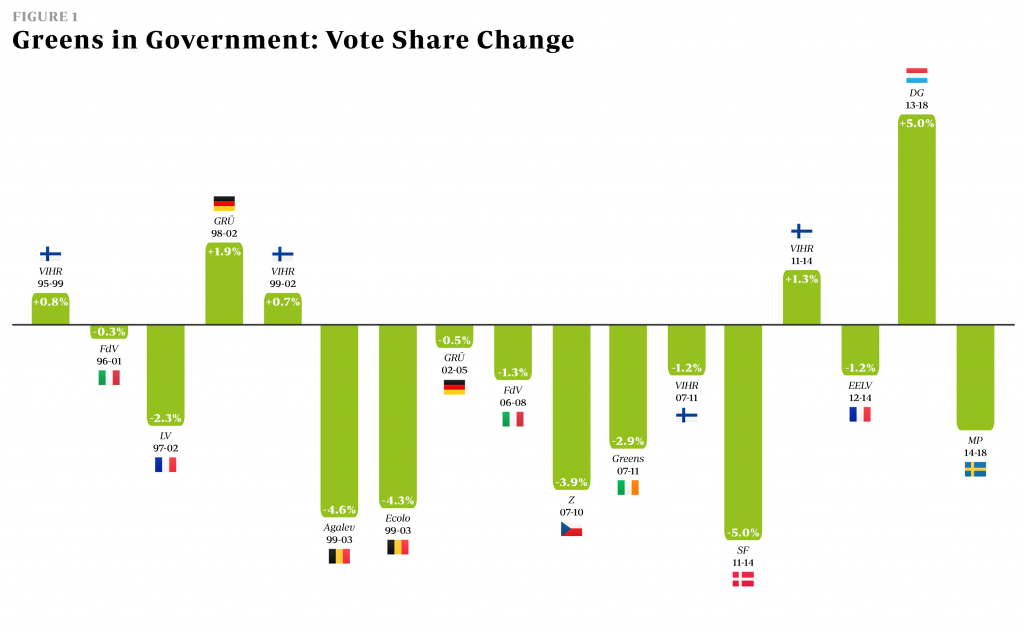
Of course, we could just stop here. However, this approach suffers from two shortcomings. Firstly, it lacks context. For example, both the Finnish and the Italian Greens lost around 1.2 per cent of their total vote share following terms in government in 2007 to 2011 and 2006 to 2008 respectively. However, while the Finnish Greens’ share fell from 8.5 per cent to 7.3 per cent, representing a drop of around 14 per cent, the Italian Greens went from 2.1 to 0.8 per cent, losing a whopping 62 per cent in the process.
In other words, in order to actually assess performance, we need to take into account the relative change in parties’ vote shares, measuring the “percentage of the percentage” of votes lost (the Italian Greens’ 62 per cent). This is when things start to get ugly. On average, between going into government and coming out the other side, the parties studied lost 21.76 per cent of their votes (see Figure 2), with more than a third of parties losing over half of their votes.
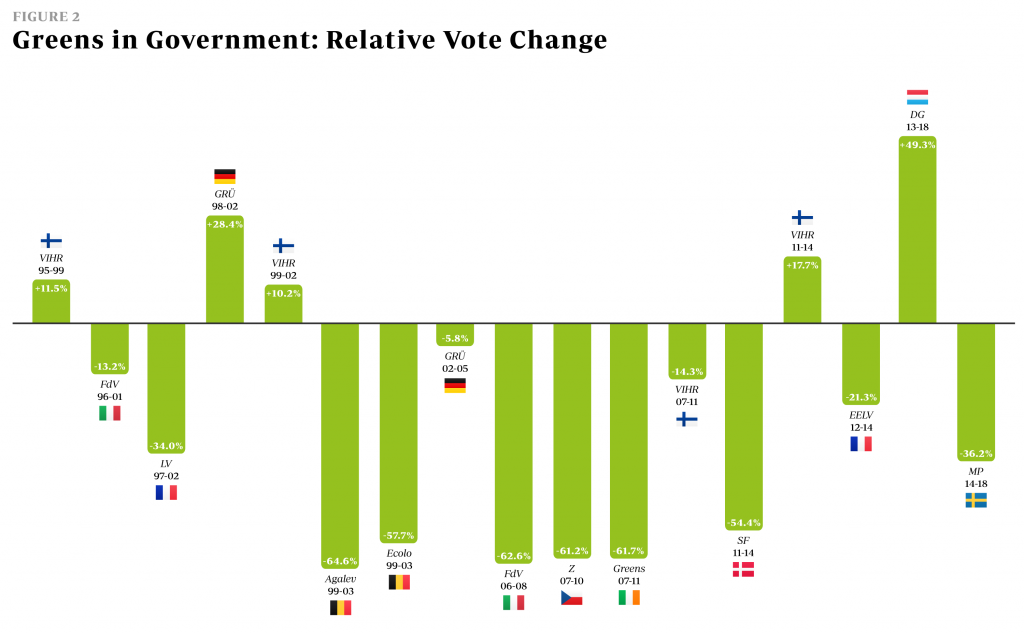
These figures should not drive us to despair, however – at least not yet. The drop in vote share could indeed represent a poor performance. Conversely, it could also mean that the first result was an unusually good performance. Parties may well sail into government on a wave of fickle voters and then revert back to their typical electoral performance (as speculated by Little). The second shortcoming of the straightforward “before” and “after” approach described above is that it fails to take this into account.
A possible solution would be to take the average result of the three elections preceding entry into government – which we can call the party’s “base performance” – and compare this to the result after a period in government. If we then apply the “relative vote share” concept, we see that the parties in question lost 3.8 per cent of their base support on average after government (see Figure 3). This is not great, but remember that it is relative. It is certainly far more reasonable, and reasoned, than the drop of 21.76 per cent resulting from a simple comparison of “just before” and “just after”. This difference suggests that the drop in vote share experienced by Green parties after government is more a reflection of particularly good performance when they enter government than of particularly poor performance when they leave it.
Appreciating this read? Be sure to CHIP IN to help fund future articles from Green Agenda.
An obvious weakness of this approach is that it does not account for the significant variation in results which is clear from even a brief glance at Figure 3. Parties did worse than their base performance on nine occasions, including the green Danish Socialist People’s Party (SF), which lost more than half of its base support in 2014. On a further seven occasions, parties performed better, including the Finnish Greens in 1999 who soared to 77 per cent above their base support level. And on one occasion, at the 2011 Finnish elections, the Greens’ performance remained practically unchanged.
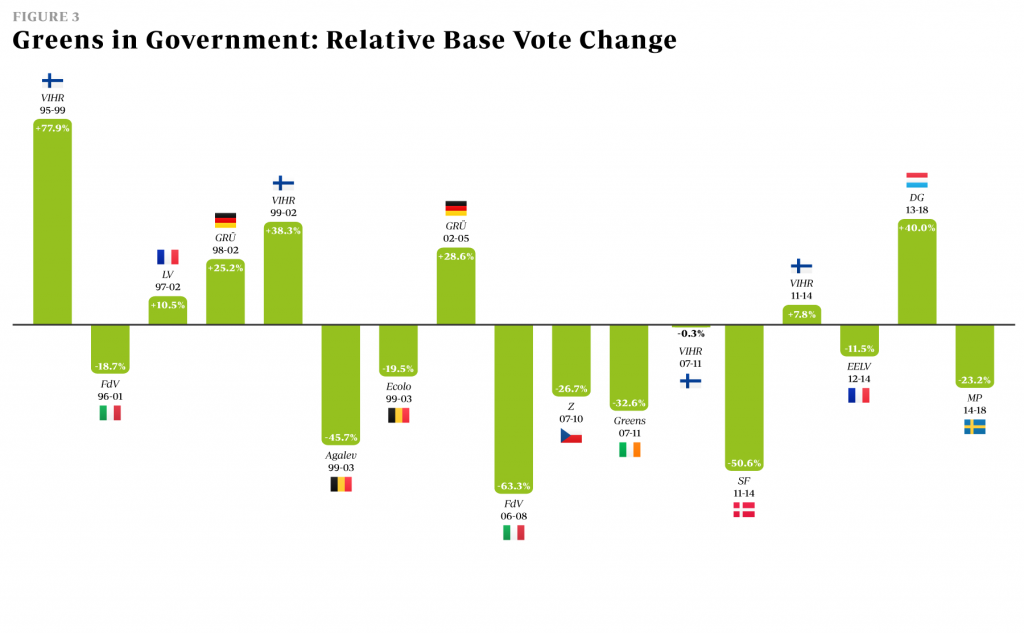
To return to our initial question, it is clear that the simple fact of going into government is no guarantee of increased Green party popularity with voters. Portfolios, ideology, coalition partners, and the decision to “defect from” a coalition are also important factors. Might these have an impact on electoral performance?
Portfolios
A key part of coalition negotiations is securing ministerial portfolios. If Green parties gain more portfolios, they should have more influence on government policy, which could make them more popular with voters.
However, a look at the data shows that there is no correlation between the number of portfolios held and a party’s electoral performance. Joint top of the list with eight ministries are the Swedish Greens (2014 to 2018), who were widely seen as failing to fulfil key promises such as a reduction of the working week and the closure of Bromma Stockholm Airport, and the Danish Socialists, whose ill-fated time in government (2011 to 2014) played out in similar fashion.
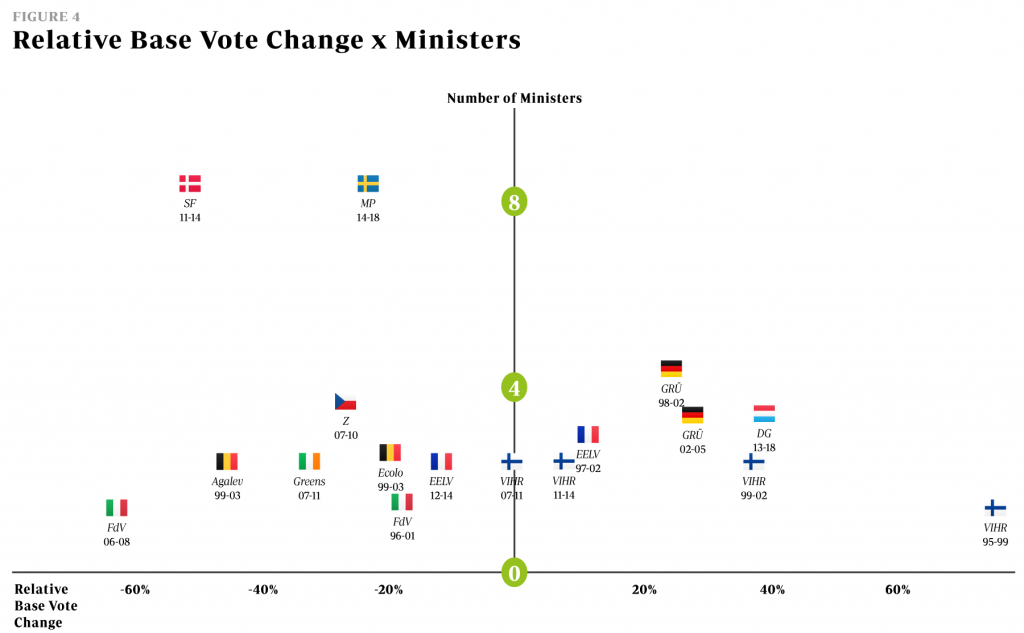
Ideology
If you ever have the pleasure of attending a European Green activist event, you will doubtless hear members debating the electoral consequences of radical politics. One of the central questions is whether radical parties can work with other parties, and therefore govern effectively, or if radicalism inevitably leads to government breakdown and punishment by voters.
However, it appears not to matter. Using the excellent Manifesto Project’s left-right ratings of party manifestos, we can look at the relationship between parties’ positions on the left-right spectrum when they enter government and their subsequent electoral performance. At first glance, the results suggest a slight correlation between being left-wing and having poor election results after a period in government. But this is misleading. As both the most left-wing party to enter government and the second most “punished” party, Danish Socialists are almost entirely responsible for this apparent correlation; without it, there is no link between ideology and election performance.
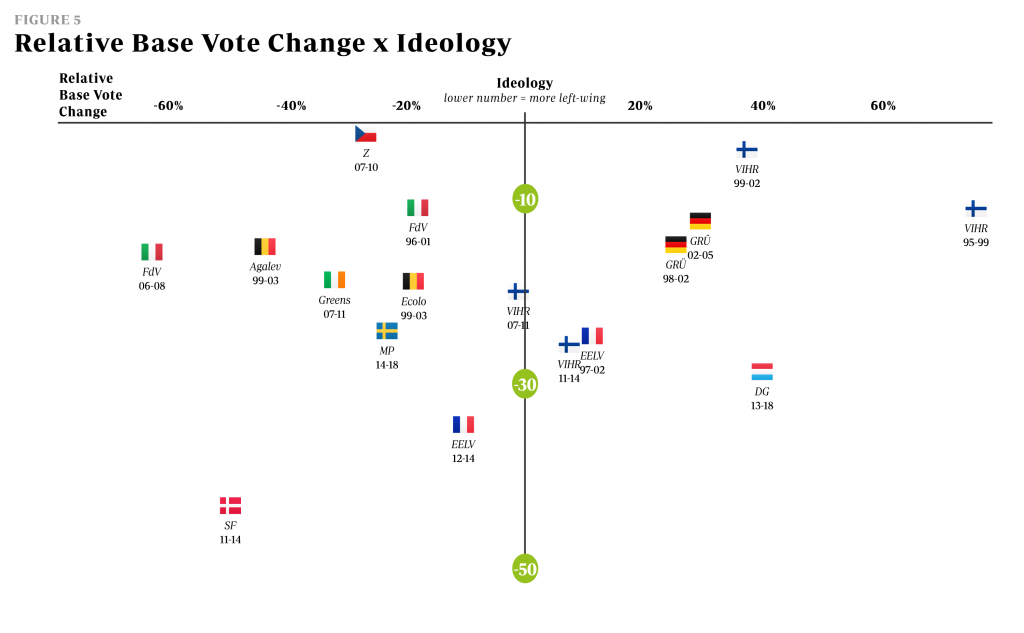
Coalition partners
Green party ideology is only part of the equation, however. The current struggles of the Austrian and Irish Green parties have sown doubt among Greens about the (as well as ethical) efficacy of going into government with conservatives. On the one hand, excessive compromise could cause voters to punish the party for not following through on its election promises. On the other, if the parties are unable to agree on policy compromises, then the government as a whole is likely to be punished by voters for incompetency. A less intuitive reason that coalition partner ideology may matter is that being in a leftist bloc may motivate tactical voting by partner parties wishing to maintain their government majority.
However, a look at the diverse types of coalitions demonstrates no obvious correlation between coalition partner ideology and electoral performance, just huge variation. For example, the Irish Greens’ first time in government could be used as a case against going into government with conservatives, with their vote share plummeting from 4.7 per cent to 1.8 per cent. Conversely, all of the four coalitions that the Finnish Greens were part of included a centrist and a centre-right party, and each spell was followed by a positive or average electoral performance by the Greens. We might speculate that this variation can be explained by the relationship between ideology and coalition partners – that is, more radical parties going into coalition with conservative parties may be more likely to be punished. However, comparing Figure 5 to the coalition partners of each Green Party does not show any obvious correlation. One unexamined explanation is political culture. In Ireland, political cooperation between parties of different ideologies is far less common than in Finland, where so-called “rainbow coalitions” are the norm rather than the exception.
Defection
The manner in which parties end their time in government is important. Nothing demonstrates this more clearly than the case of the French-speaking Green party in Belgium, Ecolo, which left the government a fortnight before the 2003 elections due to a relatively minor disagreement about overnight flights over Brussels. Even party members were troubled by this and, when election day came, the party lost nearly 20 per cent of its base performance, slumping from 11 seats to 4. As ever, there are a variety of explanations for this drop, but one of them is that parties that abruptly leave government because of policy disagreements may be punished by voters for unreliability or incompetence.
To determine whether defection generally helps or hinders Green parties, we can distinguish between parties who choose to leave government (“defect”) and those who do not (either through early elections beyond their control, or by remaining in government for an entire mandate). A look at Figure 6 makes it immediately obvious that there is a link between Green party defection and poorer than average election results. On average, defecting parties lose 12.3 per cent of their base support level, while parties that stay in government for the entire duration only lose 0.2 per cent. In other words, on average, the slightly negative electoral performance of Green parties after government is almost entirely accounted for by those parties that left government early. Of the 17 Green governments looked at for this paper, only the Finnish Greens managed to achieve a positive electoral result after defecting. In short, defection is a big deal.
Appreciating this read? Be sure to CHIP IN to help fund future articles from Green Agenda.
Why is this the case? It could be argued that Green parties tend to leave government when there is some sort of controversy (in particular, poor government performance) and this decision tends to create and/or result from internal divisions within the party. As member-led parties, such controversies tend to create public divisions. This reflection is particularly important for Green parties not only because, as they transition from opposition to governing parties, this strains their internal party organisation, but also because they are particularly prone to leaving government early.
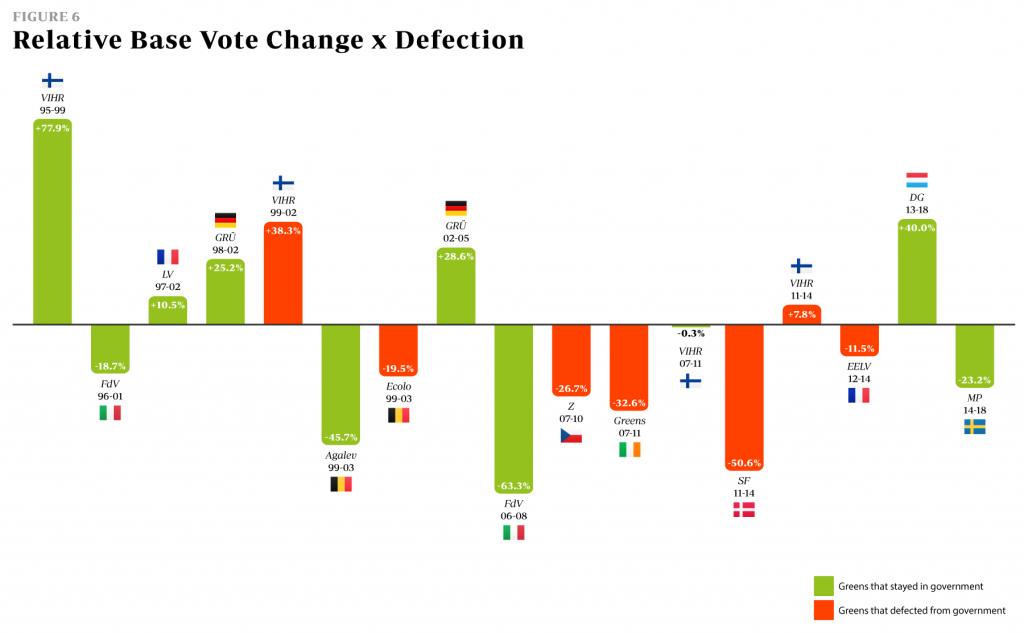
An extreme example is the Danish Socialist People’s Party (SF), whose poor post-government performance can largely be explained by its inability to work with other parties to fulfil its key promises, in addition to a series of high-profile internal disputes. After a difficult first three months in government, in which SF failed to pass a number of flagship policy promises including a millionaire tax, the party came into conflict with teaching unions. This provoked a crisis in which teachers were locked out of schools for nearly a month. Importantly, the coalition was constrained by the fact that it did not command a majority in parliament. This tumultuous two and a half years in government created deep divisions within the party. Party chair Villy Søvndal stepped down in 2012 and SF members voted in the less experienced and more radical Annette Vilhelmsen against the wishes of the party establishment. Vilhelmsen proceeded to purge the famously moderate Thor Möger Pedersen from the Ministry of Taxation, which created a backlash among prominent party figures who either resigned from their posts or abandoned the party altogether. By the time the deeply divided party defected from government, it was perceived as both “insufficiently socialist” and incompetent at governing.
If SF’s defection was dogged by internal division, the Finnish Greens’ defections in 2002 and 2011 were both notable for the party unity surrounding them. In both cases, the government as a whole was not performing particularly badly, but when the other governing parties passed policies promoting nuclear energy, the Greens stuck by their promise to oppose it and walked out of government. In 2002, the decision was not unanimous – party leader Osmo Soininvaara argued that the party should stay in government but ultimately followed the will of the majority of the party – and in 2011 any debate on the issue was side-stepped by party chair Ville Niinistö’s unilateral decision to withdraw the party from government.
Riding the wave
Contrasting these two cases illustrates what could be seen as a generalisable lesson for Green parties in Europe. Greens should not be afraid of going into government, but should be wary of entering governing coalitions they are likely to leave prematurely. This is not a particularly ground-breaking recommendation, but it does suggest a word of warning for Green parties considering coalitions with conservative parties, since the degree of compromise required makes it more likely that the Greens will defect. In turn, this has implications for internal party democracy. While it can be personally empowering for members to vote on whether their party should enter government, this tendency for direct democracy does create a platform for internal division, and could explain why Greens defect from government at such high rates. As we have seen, this overwhelmingly leads to punishment by voters.
More generally, this paper argues that seeing a drop in Green election results post-government as “punishment” is a misdiagnosis. It is not that Greens perform particularly badly after government; rather, they tend to perform particularly well when they enter government. Therefore, fear of negative repercussions at the ballot box should not discourage Green parties from entering government. Furthermore, remaining in opposition does not inoculate parties against vote loss. The Dutch GroenLinks provides a case in point. Having achieved a historically extraordinary result four years ago, the party stayed in opposition for the full mandate, only to lose half of its vote share in the following elections, returning to more or less its “base support”. While there are many individual explanations for the GroenLinks defeat, that Green party vote share tends to “revert to mean” after an extraordinary result should not surprise us, since it is the case for political parties in general.
Altogether, these findings suggest that the “green wave” metaphor is fitting. Like a wave, rising support cannot be expected to defy gravity forever. Greens should therefore be cautious about taking this wave – or its consequent opportunities to govern – for granted.
If you appreciated the read, be sure to CHIP IN, even as little as $5, to help fund future articles.
While the dataset and analysis featured in this article were developed by the author, the background research was heavily informed by the work of Conor Little and the research and guidance of Wolfgang Rüdig. The graphical representations were made possible by Filipe Henriques.
[1] For the purpose of this paper, “in government” is defined as a party holding one or more senior ministerial positions.
[2] Austria, Belgium, Bulgaria, Finland, Germany, Ireland, Luxembourg, Montenegro, North Macedonia, and Scotland.
[3] For example, see Conor Little (2016). “Green parties in government”, in Emilie van Haute (ed.). Green Parties in Europe. Routledge: London, and Wolfgang Rüdig (2006). “Is government good for Greens? Comparing the electoral effects of government participation in Western and East-Central Europe”. European Journal of Political Research, 45 (Issue s1), pp. S127-S154.
[4] The dataset collected for this paper features 17 terms of Green government in Belgium, the Czech Republic, Denmark, Finland, France, Germany, Ireland, Italy, Luxembourg, and Sweden. A number of parties served multiple terms. As this paper looks at electoral performance after government, current Green governments (including the Swedish Greens’ 2018-21 term which ended in November 2021) were not included. Research restricted to current EGP member parties.
[5] Dáil Éireann is the name of the lower house in the legislature in Ireland.
Image Source: Mikaela Valtersson (Green) and Thomas Östros (Social Democrat) present the two parties’ joint 2009 shadow budget in October 2008. At this stage the Left Party was not yet part of the cooperation. By Miljopartiet Fotograf: Johan Schiff – Own work, CC BY 3.0, https://commons.wikimedia.org/w/index.php?curid=4907816
